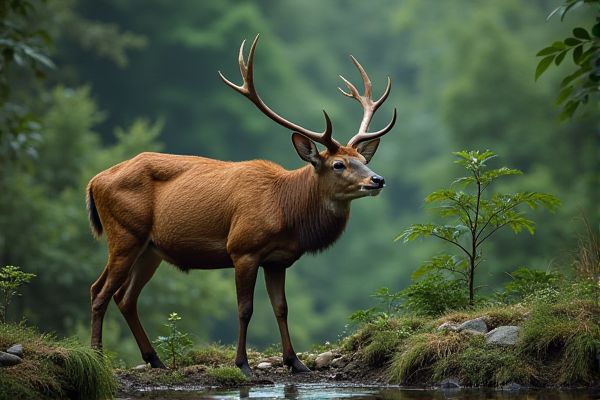
AI technology plays a crucial role in enhancing wildlife conservation efforts through data analysis and predictive modeling. Machine learning algorithms analyze large sets of ecological data to identify patterns in animal behavior, aiding in habitat protection strategies. Automated surveillance systems, powered by AI, monitor endangered species and help deter poaching, providing real-time insights into wildlife movements. Drones equipped with AI can survey hard-to-access areas, gathering valuable information while minimizing human disturbance to fragile ecosystems.
AI usage in wildlife conservation
AI-Powered Camera Traps
AI-powered camera traps enhance wildlife conservation efforts by automating the process of monitoring animal populations. For instance, organizations like the Wildlife Conservation Society utilize these technologies to analyze large amounts of data more efficiently. This allows researchers to identify species, track movements, and understand behaviors with greater accuracy. The potential for improved data collection could lead to more effective conservation strategies and better protection of endangered species.
Species Recognition Algorithms
AI usage in wildlife conservation can significantly enhance species recognition through advanced algorithms that automate identification processes. For instance, Species Recognition Algorithms improve the accuracy and speed of recognizing animal species in diverse habitats. Implementing such technology can lead to better data collection and monitoring of endangered species, thus potentially improving conservation strategies. This innovative approach strengthens partnerships among organizations like the World Wildlife Fund, enhancing collaborative conservation efforts.
Poaching Detection Systems
AI can significantly enhance wildlife conservation efforts by improving poaching detection systems. By analyzing patterns in animal movement data, AI algorithms can identify potential poaching threats in real-time. Organizations like the Smithsonian Conservation Biology Institute are already using AI-driven technologies to monitor wildlife populations and habitats. The integration of AI could lead to more effective resource allocation and ultimately contribute to the preservation of endangered species.
Population Monitoring Tools
AI usage in wildlife conservation can enhance population monitoring tools significantly. By analyzing vast amounts of data, such as animal movement patterns and population densities, AI algorithms can provide more accurate assessments of species health. For example, the collaboration between AI systems and organizations like the World Wildlife Fund (WWF) showcases the potential for better habitat management. This integration increases the chances of making informed decisions to protect endangered species and their environments.
Habitat Mapping and Analysis
AI technology can significantly enhance wildlife conservation efforts by improving habitat mapping and analysis. For instance, machine learning algorithms can analyze satellite imagery to identify critical habitats for endangered species. Organizations like the World Wildlife Fund (WWF) utilize AI to monitor animal populations and their movements, enabling targeted conservation measures. By leveraging these advanced tools, researchers can increase the chances of preserving biodiversity and creating sustainable ecosystems.
Predictive Migration Modeling
AI usage in wildlife conservation can enhance predictive migration modeling, allowing for better understanding of animal movement patterns. For instance, the integration of satellite telemetry data can inform conservation strategies for endangered species like the California condor. Improved modeling techniques may lead to more effective habitat preservation and protection measures. This data-driven approach increases the chances of success in mitigating threats to wildlife populations.
Acoustic Monitoring Technologies
AI usage in wildlife conservation can enhance tracking and monitoring of animal populations through acoustic monitoring technologies. These systems, capable of capturing sounds from natural habitats, can identify species presence and behaviors. For instance, tools like automated sound recognition can help researchers at conservation institutions analyze vocalizations. This improvement in data collection may increase the chances of effective intervention strategies and habitat protection.
Drones with AI Guidance
Drones equipped with AI guidance have the potential to revolutionize wildlife conservation efforts. They can enhance monitoring capabilities by enabling real-time data collection and analysis, allowing organizations like the World Wildlife Fund to track animal populations and habitats more effectively. This technology may improve the detection of poaching activities, increasing the chances of timely intervention. The integration of AI with drone technology offers a promising path for more efficient resource allocation and a better understanding of ecosystem dynamics.
Climate Impact Assessments
AI can enhance wildlife conservation efforts by analyzing large datasets to predict animal migration patterns and habitat changes. Tools like machine learning could assist organizations such as WWF in assessing the impact of climate change on biodiversity. This data-driven approach may improve the effectiveness of protection strategies, potentially leading to better survival rates for endangered species. The chance of mitigating adverse effects on ecosystems through precise predictions could significantly benefit conservation initiatives.
Genetic Diversity Analysis Tools
AI can significantly enhance wildlife conservation efforts, particularly through genetic diversity analysis tools. These tools enable researchers to evaluate the genetic health of species populations, informing strategies for breeding and habitat management. For instance, using platforms like GenAlEx, conservationists can identify genetic bottlenecks and assess the impact of environmental changes. This approach increases the likelihood of successfully preserving endangered species and maintaining biodiversity.
 techknowy.com
techknowy.com